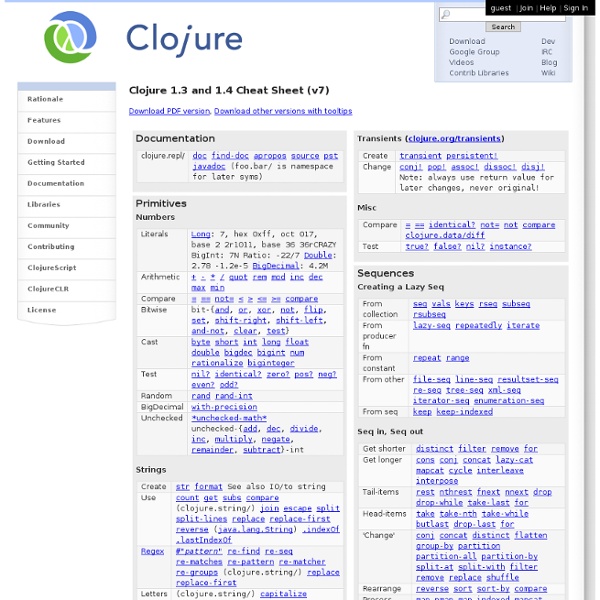



Clojure Notes Casting SPELs with Clojure - Home - Anyone who has ever learned to program in Lisp will tell you it is very different from any other programming language. It is different in lots of surprising ways - This comic book will let you find out how Lisp's unique design makes it so powerful ! This tutorial was adapted for Clojure, an exciting new dialect of Lisp running on the Java Virtual Machine. Most of the time, we will say "Lisp" instead of "Clojure", since most of the concepts presented apply to Lisp in general - we will point out the places where Clojure handles things a little different. Since Clojure is based on the JVM, you will need to have Java installed on your system. For the examples in this tutorial, simply unpack the archive, open a command line tool and switch to Clojure's main directory. java -jar clojure.jar If everything is working correctly, you should see Clojure's input prompt, which should look similar to this: Clojure 1.1.0 user=> This tutorial has small bits of Clojure code written in '(these kinds of boxes)
home Mark Volkmann's Clojure Page Mark Volkmann's Page This page contains resources related to the Clojure programming language. Article Change History Sounds Even Jennifer Aniston has quit using other programming languages and now prefers Clojure. Sound Clip #1 Sound Clip #2
Clojure Programming - Wikibooks, collection of open-content textbooks Clojure is a dynamic programming language for the JVM. Introduction[edit] People come to Clojure from a variety of backgrounds. Feel free to post your own code, written in the Clojure language, here. Implementations[edit] There are a number of different implementations of the Clojure language: Clojure (the original Java-based implementation)ClojureScript (compiles to JavaScript)ClojureCLR (for Microsoft's .NET framework)clojure-py (Python-based)clojure-scheme (compiles to Scheme)ClojureC (compiles to C) See also Clojure-metal (thoughts/plans for Clojure on LLVM). FAQ[edit] Some answers to Frequently Asked Questions. Getting started[edit] The Getting started section covers obtaining and installing Clojure as well as basic setup of editors such as Emacs or Vim. Other "Getting Started" guides and documentation: Concepts[edit] The Concepts section covers Clojure language basics, such as supported datatypes, "mutability" or state in Clojure, functional programming and the concurrency features.
Fatvat: Data Persistence in GAE with Clojure If you want to persist stuff in Java, you've got a bewildering amount of choiceThere's even an entire book about making the right decision! (Persistence in the Enterprise) Google App Engine has gone with JDO using the Data Nucleus platform. In GAE this is split again into two APIs, the high-level one for persisting objects, and a lower-level one which allows you to persist raw data. When using Clojure it makes more sense to go with the lower-level api. So how do we store data in GAE? (ns news.savestory (:use (news appengine)) (:gen-class :extends javax.servlet.http.HttpServlet) (:import (com.google.appengine.api.datastore DatastoreServiceFactory Entity Key Query))) (defn store [data type] (let [entity (Entity. (.toString type))] (doseq [[k v] data] (.setProperty entity (.toString k) v)) (.put (DatastoreServiceFactory/getDatastoreService) entity) (.getKey entity))) store takes a map and a type and persists it in the database and returns the key associated with this entity.
Learn Clojure Clojure Series: Table of Contents Writing/Coding Writing and Coding, Literature and Computers Tuesday, June 17, 2008 Clojure Series: Table of Contents Here are the postings I have published so far for this series. Posted by Eric Rochester at 5:52 PM Labels: clojure, clojure-series 9 comments: geekiac said... Thank you for writing on Clojure. June 25, 2008 at 5:32 AM Eric Rochester said... @geekiacI'm glad you're liking it. June 25, 2008 at 8:38 AM Paul Drummond said... Nice articles, looking forward to reading more! June 26, 2008 at 7:18 AM Great! June 26, 2008 at 8:57 AM Everything is very clear so far - it's a nice gentle introduction and I already know most of what has been covered so far. June 26, 2008 at 9:21 AM Everything being immutable is a different way of doing things, and sometimes it can be hard to get your head around.Have you seen the Rich's screencast about data types? June 26, 2008 at 5:14 PM June 27, 2008 at 3:49 AM Fogus said... Great job so far! September 18, 2008 at 11:48 AM Bryan Kyle said... August 19, 2010 at 1:50 PM